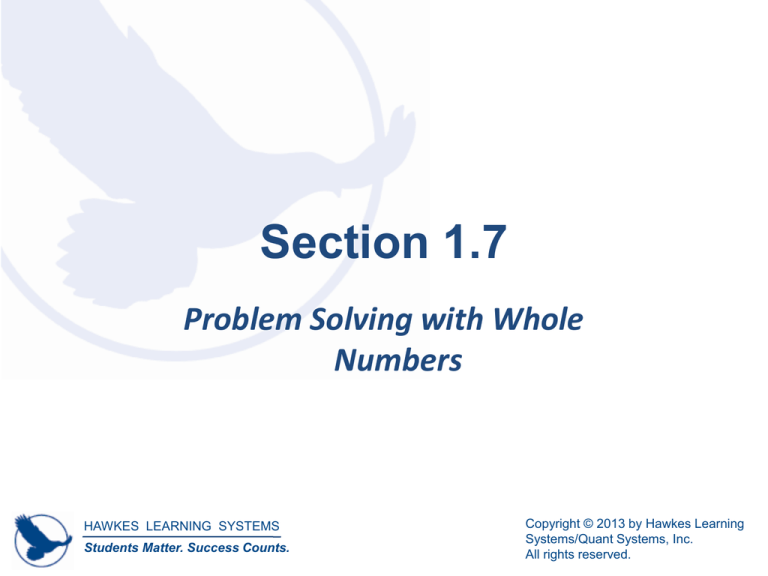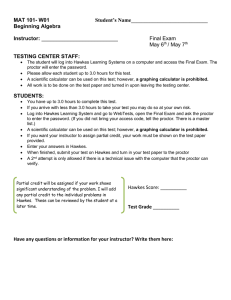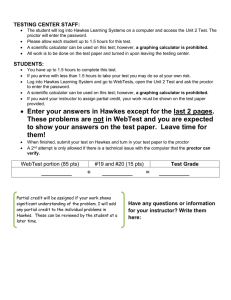
Section 1.7
Problem Solving with Whole
Numbers
HAWKES LEARNING SYSTEMS
Students Matter. Success Counts.
Copyright © 2013 by Hawkes Learning
Systems/Quant Systems, Inc.
All rights reserved.
Objectives
o Learn the basic strategy for solving word problems.
o Analyze and solve word problems involving numbers.
o Analyze and solve word problems involving consumer
items.
o Analyze and solve word problems involving checking
accounts.
o Analyze and solve word problems involving average.
HAWKES LEARNING SYSTEMS
Students Matter. Success Counts.
Copyright © 2013 by Hawkes Learning
Systems/Quant Systems, Inc.
All rights reserved.
Basic Strategy for Solving Word Problems
Basic Strategy for Solving Word Problems
1. Read the problem carefully.
2. Draw any type of figure or diagram that might be
helpful and decide what operations are needed.
3. Perform the operations to solve the problem.
4. Check your work.
HAWKES LEARNING SYSTEMS
Students Matter. Success Counts.
Copyright © 2013 by Hawkes Learning
Systems/Quant Systems, Inc.
All rights reserved.
Problem Solving: Number Problems
Key Words that Indicate Operations
Addition
Subtraction Multiplication Division
add
subtract
multiply
divide
sum
difference
product
quotient
plus
minus
times
ratio
more than
less than
twice
increased by decreased by double
total
HAWKES LEARNING SYSTEMS
Students Matter. Success Counts.
Copyright © 2013 by Hawkes Learning
Systems/Quant Systems, Inc.
All rights reserved.
Example 1: Number Problem
Find the sum of 78 and 93. Then double the sum.
What is the result?
Solution
The key word sum indicates addition.
78
93
171
HAWKES LEARNING SYSTEMS
Students Matter. Success Counts.
sum
Copyright © 2013 by Hawkes Learning
Systems/Quant Systems, Inc.
All rights reserved.
Example 1: Number Problem (cont.)
Double means to multiply by 2.
171
2
342
HAWKES LEARNING SYSTEMS
Students Matter. Success Counts.
product
Copyright © 2013 by Hawkes Learning
Systems/Quant Systems, Inc.
All rights reserved.
Example 2: Number Problem
If the quotient of 265 and 5 is decreased by 36, what is
the difference?
Solution
The key word quotient indicates division.
53
5 265
25
15
15
0
HAWKES LEARNING SYSTEMS
Students Matter. Success Counts.
quotient
Copyright © 2013 by Hawkes Learning
Systems/Quant Systems, Inc.
All rights reserved.
Example 2: Number Problem (cont.)
Decreased by indicates subtraction.
53
36
17
HAWKES LEARNING SYSTEMS
Students Matter. Success Counts.
difference
Copyright © 2013 by Hawkes Learning
Systems/Quant Systems, Inc.
All rights reserved.
Example 3: Number Problem
If the product of 15 and 32 is added to 1500, what is
the total?
Solution
The key word product indicates multiplication.
32
15
160
32
480
HAWKES LEARNING SYSTEMS
Students Matter. Success Counts.
product
Copyright © 2013 by Hawkes Learning
Systems/Quant Systems, Inc.
All rights reserved.
Example 3: Number Problem (cont.)
Added to indicates addition.
1500
480
1980
HAWKES LEARNING SYSTEMS
Students Matter. Success Counts.
total
Copyright © 2013 by Hawkes Learning
Systems/Quant Systems, Inc.
All rights reserved.
Example 4: Consumer Items
Mr. Lukin bought a used car for $8000. Taxes of $640
and license fees of $320 were then added to the
purchase price. He made a down payment of $2000
and financed the rest through his credit union. What
was the amount of his loan from the credit union?
Solution
First, find his total cost by adding the expenses. Then
subtract his down payment. This difference will be the
amount of his loan.
HAWKES LEARNING SYSTEMS
Students Matter. Success Counts.
Copyright © 2013 by Hawkes Learning
Systems/Quant Systems, Inc.
All rights reserved.
Example 4: Consumer Items (cont.)
Add expenses
$8000
price
640
320
$8960
taxes
license fees
Subtract down payment
$8960
2000
$6960
total expenses
down payment
amount of loan
total expenses
After a down payment of $2000, his loan will be $6960.
HAWKES LEARNING SYSTEMS
Students Matter. Success Counts.
Copyright © 2013 by Hawkes Learning
Systems/Quant Systems, Inc.
All rights reserved.
Example 5: Checking Accounts
In January, Kathleen opened a checking account and
deposited $2500. During the month, she made
another deposit of $800 and wrote checks for $132,
$425, $196, and $350. What was the balance in her
account at the end of the month?
Solution
First, find the sum of her deposits.
$2500
800
$3300 total deposits
HAWKES LEARNING SYSTEMS
Students Matter. Success Counts.
Copyright © 2013 by Hawkes Learning
Systems/Quant Systems, Inc.
All rights reserved.
Example 5: Checking Accounts (cont.)
Then find the sum of her checks.
$132
425
196
350
$1103
HAWKES LEARNING SYSTEMS
Students Matter. Success Counts.
total of checks
Copyright © 2013 by Hawkes Learning
Systems/Quant Systems, Inc.
All rights reserved.
Example 5: Checking Accounts (cont.)
Finally, find the balance by subtracting.
$3300
1103
$2197
HAWKES LEARNING SYSTEMS
Students Matter. Success Counts.
balance
Copyright © 2013 by Hawkes Learning
Systems/Quant Systems, Inc.
All rights reserved.
Problem Solving: Average
To Find the Average of a Set of Numbers
Step 1: Find the sum of the given set of numbers.
Step 2: Divide this sum by the number of numbers in
the set. This quotient is called the average of
the given set of numbers.
HAWKES LEARNING SYSTEMS
Students Matter. Success Counts.
Copyright © 2013 by Hawkes Learning
Systems/Quant Systems, Inc.
All rights reserved.
Example 6: Average
Find the average of the following set of numbers: 15, 8,
90, 35, 27.
Solution
Step 1: First, find the sum of the numbers.
15
8
90
35
27
175
HAWKES LEARNING SYSTEMS
Students Matter. Success Counts.
Copyright © 2013 by Hawkes Learning
Systems/Quant Systems, Inc.
All rights reserved.
Example 6: Average (cont.)
Step 2: Now, divide the sum by 5, since we have a list
of five numbers.
35
5 175
15
25
25
0
average
The average of the set of numbers is 35.
HAWKES LEARNING SYSTEMS
Students Matter. Success Counts.
Copyright © 2013 by Hawkes Learning
Systems/Quant Systems, Inc.
All rights reserved.
Example 7: Average
Top-Notch Sporting Goods recorded its profits for
tennis rackets for six months. The profits were:
January, $5380; February, $7590; March, $6410; April,
$4530; May, $5840; June, $6250. Below is a bar graph
with this information.
a. In what month were the profits the most?
b. In what month were the profits the least?
c. What is the average monthly profit over the six
months?
HAWKES LEARNING SYSTEMS
Students Matter. Success Counts.
Copyright © 2013 by Hawkes Learning
Systems/Quant Systems, Inc.
All rights reserved.
Example 7: Average (cont.)
HAWKES LEARNING SYSTEMS
Students Matter. Success Counts.
Copyright © 2013 by Hawkes Learning
Systems/Quant Systems, Inc.
All rights reserved.
Example 7: Average (cont.)
Solution
a. From the bar graph, we can see that the month with
the most profits was February with $7590.
b. April was the month with the least profits with
$4530.
c. The average monthly profit can be found by finding
the sum of the profits for each month and dividing
by 6.
HAWKES LEARNING SYSTEMS
Students Matter. Success Counts.
Copyright © 2013 by Hawkes Learning
Systems/Quant Systems, Inc.
All rights reserved.
Example 7: Average (cont.)
Add profits
Divide by 6
$5380
6 000 average
7590
6 36,000
36 000
6410
4530
0
5840
6250
$36,000
The average profit each month for the six months was
$6000.
HAWKES LEARNING SYSTEMS
Students Matter. Success Counts.
Copyright © 2013 by Hawkes Learning
Systems/Quant Systems, Inc.
All rights reserved.
Example 7: Average (cont.)
(In this case, we see that the average can be very
useful. The store manager can use the monthly profits
for planning and budgeting.)
HAWKES LEARNING SYSTEMS
Students Matter. Success Counts.
Copyright © 2013 by Hawkes Learning
Systems/Quant Systems, Inc.
All rights reserved.
Example 8: Average
Five people in a survey reported the following incomes
for one year: $18,000; $28,000; $20,000; $20,000;
$214,000. What was the average annual income for
these five people?
HAWKES LEARNING SYSTEMS
Students Matter. Success Counts.
Copyright © 2013 by Hawkes Learning
Systems/Quant Systems, Inc.
All rights reserved.
Example 8: Average (cont.)
Solution
Add incomes
$18,000
28,000
20,000
20,000
214,000
Divide by 5
60 000
5 300,000
300, 000
average
0
$300,000
The average income was $60,000.
HAWKES LEARNING SYSTEMS
Students Matter. Success Counts.
Copyright © 2013 by Hawkes Learning
Systems/Quant Systems, Inc.
All rights reserved.
Example 8: Average (cont.)
(Because of one large income, the average income was
much higher then the income of the other four people.
Judging the importance of an average, particularly in a
case like this, is up to the reader of the information.)
HAWKES LEARNING SYSTEMS
Students Matter. Success Counts.
Copyright © 2013 by Hawkes Learning
Systems/Quant Systems, Inc.
All rights reserved.
Example 9: Average
On an English exam, two students scored 95, five
scored 86, one scored 82, one scored 78, and six scored
75. What was the average score for the class?
Solution
There were fifteen students in the class. We can
multiply as follows rather than add all fifteen scores.
95
2
190
86
5
430
HAWKES LEARNING SYSTEMS
Students Matter. Success Counts.
82
1
82
78
1
78
75
6
450
Copyright © 2013 by Hawkes Learning
Systems/Quant Systems, Inc.
All rights reserved.
Example 9: Average (cont.)
Next, we add the five products to find the sum of all of
the scores.
190
430
82
78
450
1230
HAWKES LEARNING SYSTEMS
Students Matter. Success Counts.
Copyright © 2013 by Hawkes Learning
Systems/Quant Systems, Inc.
All rights reserved.
Example 9: Average (cont.)
Finally, divide by 15 because the total represents 15
scores.
8 2 average
15 1230
120
30
30
0
The average score was 82.
HAWKES LEARNING SYSTEMS
Students Matter. Success Counts.
Copyright © 2013 by Hawkes Learning
Systems/Quant Systems, Inc.
All rights reserved.
Practice Problems
1. Find the sum of the three numbers 915, 862, and
453. Then subtract 580. What is the quotient if the
difference is divided by 3?
2. David bought an iPhone® for $250. He had a
coupon that gave him $10 off. He also bought 3
video games for $48 each. What did he pay overall
for the iPhone® and the video games?
HAWKES LEARNING SYSTEMS
Students Matter. Success Counts.
Copyright © 2013 by Hawkes Learning
Systems/Quant Systems, Inc.
All rights reserved.
Practice Problems
3. Mr. Morton opened a checking account and
deposited $4000. He wrote two checks for $175
each and one for $300. What was his balance after
writing these checks?
4. The Lee family spent the following amounts for
groceries: $338 in June; $307 in July; $318 in
August. What was the average amount they spent
for groceries for these three months?
HAWKES LEARNING SYSTEMS
Students Matter. Success Counts.
Copyright © 2013 by Hawkes Learning
Systems/Quant Systems, Inc.
All rights reserved.
Practice Problem Answers
1.
2.
3.
4.
550
$384
$3350
$321
HAWKES LEARNING SYSTEMS
Students Matter. Success Counts.
Copyright © 2013 by Hawkes Learning
Systems/Quant Systems, Inc.
All rights reserved.




